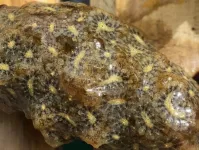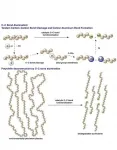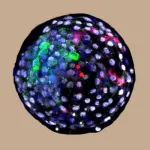Environmental protection could benefit from 'micro' as well as 'macro' thinking
2021-04-15
(Press-News.org) Scientists at the University of Southampton have conducted a study that highlights the importance of studying a full range of organisms when measuring the impact of environmental change - from tiny bacteria, to mighty whales.
Researchers at the University's School of Ocean and Earth Science, working with colleagues at the universities of Bangor, Sydney and Johannesburg and the UK's National Oceanography Centre, undertook a survey of marine animals, protists (single cellular organisms) and bacteria along the coastline of South Africa.
Lead researcher and postgraduate student at the University of Southampton, Luke Holman explains: "Typically, biodiversity and biogeography studies focus on one group of species at a time, often animals. Studying animals, protist and bacteria together - organisms vastly different in size, separated by billions of years of evolution - gave us the opportunity to take a broader view of the marine ecosystem. We discovered remarkably consistent biogeographic groupings for the three across the coastline - consistent with previously studied patterns, driven by regional currents."
Findings are published in the journal Nature Ecology and Evolution.
The team took seawater samples in numerous locations along the length of the South African coast, from the warmer seas of the east, to the cooler waters of the west and the intermediate temperatures in the south. The samples were filtered, had environmental DNA extracted and underwent sophisticated lab analysis to indicate the diverse range of organisms found in particular locations.
Results showed a broad range of animals living in the sea along the whole length of coast, but with differences in the exact species in warm, cold and intermediate regions. This same pattern of difference was also shown in bacteria and protists - demonstrating consistency in the biodiversity of life for each region.
Furthermore, the scientists found that among the variables examined temperature had the greatest impact on determining the diversity of animals and bacteria, whereas protists were associated more with chlorophyll concentration in the water. The team also revealed that while all three groups were affected to some extent by human activity, such as shipping, fishing and building of marinas, this wasn't to the extent they'd expected.
Commenting on the study, Luke said: "We hope our work encourages researchers to consider other groups of organisms, both in biogeographic assessments and marine protection and restoration projects. For example, a project aiming to restore a coral reef might also need to consider the bacterial communities, or the protection of a river system might also ensure the protists communities are monitored in addition to the fish."
Moving forwards the team hope to learn more about the causes and consequences of global marine biodiversity change for all life, from microscopic bacteria and protists to macroscopic organisms like fish and marine mammals.
INFORMATION:
Notes to Editors
1) For interviews with Luke Holman, please contact Peter Franklin, Media Relations, University of Southampton. Email: p.franklin@southampton.ac.uk Tel: 07748 321087
2) The paper Animals, protists and bacteria share marine biogeographic patterns is published in the journal Nature Ecology and Evolution (DOI: 10.1038/s41559-021-01439-7) and can be found at https://dx.doi.org/10.1038/s41559-021-01439-7 after the embargo has lifted.
3) The University of Southampton drives original thinking, turns knowledge into action and impact, and creates solutions to the world's challenges. We are among the top 100 institutions globally (QS World University Rankings 2021). Our academics are leaders in their fields, forging links with high-profile international businesses and organisations, and inspiring a 22,000-strong community of exceptional students, from over 135 countries worldwide. Through our high-quality education, the University helps students on a journey of discovery to realise their potential and join our global network of over 200,000 alumni. http://www.southampton.ac.uk
4) For further information about the School of Ocean and Earth Science at the University of Southampton visit: https://www.southampton.ac.uk/oes/index.page
5) For more on the universities of Bangor, Sydney and Johannesburg visit:
https://www.bangor.ac.uk/
https://www.sydney.edu.au/
https://www.uj.ac.za/
[Attachments] See images for this press release:

ELSE PRESS RELEASES FROM THIS DATE:
2021-04-15
The dynamics of the neural activity of a mouse brain behave in a peculiar, unexpected way that can be theoretically modeled without any fine tuning, suggests a new paper by physicists at Emory University. Physical Review Letters published the research, which adds to the evidence that theoretical physics frameworks may aid in the understanding of large-scale brain activity.
"Our theoretical model agrees with previous experimental work on the brains of mice to a few percent accuracy -- a degree which is highly unusual for living systems," says Ilya Nemenman, Emory professor of physics and biology and senior author of the paper.
The ...
2021-04-15
Scientists at the Institute for Cooperative Upcycling of Plastics (iCOUP), an Energy Frontier Research Center led by Ames Laboratory, have discovered a chemical process that provides biodegradable, valuable chemicals, which are used as surfactants and detergents in a range of applications, from discarded plastics. The process has the potential to create more sustainable and economically favorable lifecycles for plastics.
The researchers targeted their work on the deconstruction of polyolefins, which represents more than half of all discarded plastics, and includes nearly every kind of product imaginable-- toys, food packaging, pipe systems, water ...
2021-04-15
A new review published in EPJ H by Clara Matteuzzi, Research Director at the National Institute for Nuclear Physics (INFN) and former tenured professor at the University of Milan, and her colleagues, examines almost three decades of the LHCb experiment - from its conception to operation at the Large Hadron Collider (LHC) - documenting its achievements and future potential.
The LCHb experiment was originally conceived to understand the symmetry between matter and antimatter and where this symmetry is broken - known as charge conjugation parity (CP) violation. Whilst this may seem like quite an obscure area of study, it addresses one of the Universe's most fundamental questions: how it came to be dominated ...
2021-04-15
As the world's energy demands grow, so too does growing concern over the environmental impact of power production. The need for a safe, clean, and reliable energy source has never been clearer. Fusion power could fulfil such a need. A review paper published in EPJ H examines the 6-decade history of neutral particle analysis (NPA), developed in Ioffe Institute, Saint Petersburg, Russia, a vital diagnostic tool used in magnetic plasma confinement devices such as tokamaks that will house the nuclear fusion process and generate the clean energy of the future.
As ...
2021-04-15
Investigators in China and the United States have injected human stem cells into primate embryos and were able to grow chimeric embryos for a significant period of time--up to 20 days. The research, despite its ethical concerns, has the potential to provide new insights into developmental biology and evolution. It also has implications for developing new models of human biology and disease. The work appears April 15 in the journal Cell.
"As we are unable to conduct certain types of experiments in humans, it is essential that we have better models to more accurately study and understand human biology and disease," says senior author Juan Carlos Izpisua Belmonte, a professor in the Gene Expression ...
2021-04-15
LA JOLLA--(April 15, 2021) The ability to grow the cells of one species within an organism of a different species offers scientists a powerful tool for research and medicine. It's an approach that could advance our understanding of early human development, disease onset and progression and aging; provide innovative platforms for drug evaluation; and address the critical need for transplantable organs. Yet developing such capabilities has been a formidable challenge.
Researchers led by Salk Professor Juan Carlos Izpisua Belmonte have now come one step closer toward this goal by demonstrating a new integration of human cells into animal tissue. Published in the journal Cell on April 15, 2021, the new study builds upon previous work by the Izpisua Belmonte lab to take the next step in chimeric ...
2021-04-15
Illustration
A lot of attention has been paid in recent years to the carbon footprint of the foods we eat, with much of the focus on the outsize contribution of meat production and especially beef.
But much less is known about the implications of individual U.S. dietary choices on other environmental concerns, such as water scarcity.
In a study scheduled for online publication April 15 in the journal Nature Food, researchers from the University of Michigan and Tulane University present a water scarcity footprint that measures the water-use impacts of U.S. diets, taking into ...
2021-04-15
Coral reefs provide many services to coastal communities, including critical protection from flood damage. A new study led by researchers at the University of California, Santa Cruz, and the U.S. Geological Survey reveals how valuable coral reefs are in protecting people, structures, and economic activity in the United States from coastal flooding during storms.
Published April 15 in Nature Sustainability, the study found that coral reefs offer more than $1.8 billion in annual flood protection to coastal communities. Losing 1 meter of reef height would cause 100-year flooding zones to increase by 23%, impacting 53,800 more people (a 62% increase) and 90% more property and increasing damages by $5.3 billion.
The study also found that the United States has ...
2021-04-15
In a novel laboratory investigation of the initial atmospheres of Earth-like rocky planets, researchers at UC Santa Cruz heated pristine meteorite samples in a high-temperature furnace and analyzed the gases released.
Their results, published April 15 in Nature Astronomy, suggest that the initial atmospheres of terrestrial planets may differ significantly from many of the common assumptions used in theoretical models of planetary atmospheres.
"This information will be important when we start being able to observe exoplanet atmospheres with new telescopes and advanced instrumentation," said first author Maggie Thompson, a graduate student in astronomy and astrophysics at UC Santa Cruz.
The early atmospheres of rocky planets are ...
2021-04-15
It has long been known that obesity is an inflammatory disease, i.e. a chronic defensive reaction of the body to stress caused by excess nutrients. Based on this knowledge, a group of researchers led by Nabil Djouder, head of the Growth Factors, Nutrients and Cancer Group at the Spanish National Cancer Research Centre (CNIO), decided to try to fight obesity by preventing inflammation - and they succeeded. Their paper, published this week in Nature Metabolism, shows that digoxin, a drug already in use against heart diseases, reduces inflammation and leads to a 40% weight loss in obese mice, without any side effects.
Digoxin reverses obesity completely: treated mice attain the same weight as healthy, non-obese animals. The ...
LAST 30 PRESS RELEASES:
[Press-News.org] Environmental protection could benefit from 'micro' as well as 'macro' thinking





